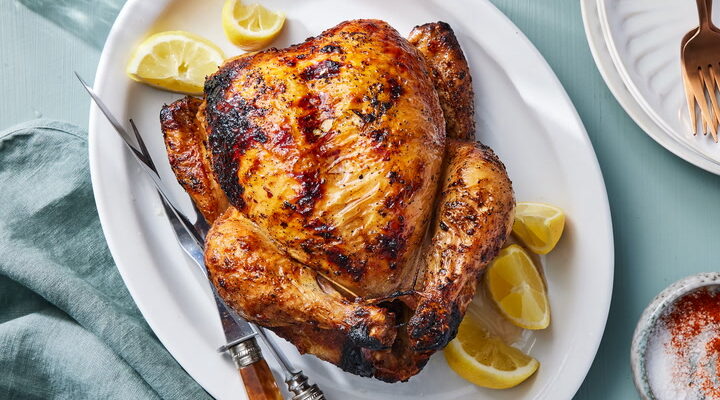Smoked Chicken Recipe: There’s something magical about the smell of smoked meat wafting through the air. Smoked chicken is not just food—it’s an experience. The deep, smoky flavor infused into juicy, tender chicken creates a culinary delight that’s hard to beat. Unlike traditional grilled or roasted chicken, smoking allows the meat to absorb complex flavors over a low and slow cook. This technique breaks down the connective tissues, resulting in a melt-in-your-mouth texture that’s utterly irresistible.
Smoked chicken also brings that wow factor to any gathering. Whether it’s a family BBQ, a weekend cookout, or a festive celebration, this dish is always a showstopper. Plus, it’s healthier than fried options and offers a protein-rich meal packed with flavor without being greasy or overly fatty.
Popularity and Versatility of Smoked Chicken
One reason smoked chicken has gained such a following is its incredible versatility. You can use it in sandwiches, salads, tacos, or even pasta dishes. The leftovers are just as good—maybe even better—as the flavors continue to deepen overnight.
Moreover, smoked chicken isn’t just for summer. It’s a year-round favorite. With indoor electric smokers and outdoor pellet grills, it’s easy to enjoy this smoky sensation no matter the season. From backyard chefs to pitmasters, everyone appreciates a perfectly smoked bird.
Ingredients You’ll Need
Chicken Selection Tips
The star of the show here is obviously the chicken. You can choose a whole chicken or go with cuts like thighs, drumsticks, or breasts. However, whole chickens are usually preferred for smoking because they retain more moisture and offer a more even flavor throughout.
When selecting chicken, always go for fresh, organic, or free-range if possible. The quality of the meat makes a noticeable difference in both flavor and texture. Make sure the skin is intact if you want a crispy finish post-smoking. Also, opt for birds between 3.5 to 4.5 pounds for the best balance between cook time and flavor absorption.
Essential Ingredients for Marinade and Rub
Here’s where the flavor foundation is built. A good rub and/or marinade can transform your chicken into a savory masterpiece. Here’s a basic list:
Dry Rub Ingredients:
- 2 tbsp brown sugar
- 1 tbsp smoked paprika
- 1 tbsp garlic powder
- 1 tbsp onion powder
- 1 tsp cayenne pepper (adjust for heat)
- 1 tsp black pepper
- 1 tsp kosher salt
- 1 tsp dried thyme or oregano
Optional Marinade (for added depth):
- 1/2 cup olive oil
- 1/4 cup apple cider vinegar
- Juice of 1 lemon
- 4 cloves of garlic, minced
- Fresh herbs (rosemary, thyme)
Mix the rub ingredients thoroughly and massage them into the chicken. If using the marinade, let the chicken soak for at least 4–6 hours, preferably overnight.
Optional Add-ons for Extra Flavor
Want to kick it up a notch? Try these add-ons:
- Injection marinade: Using a meat injector to infuse apple juice or seasoned broth directly into the meat.
- Beer or apple cider can: Smoking a chicken over an open beer or cider can for juicy, flavorful meat.
- Butter under the skin: Adds richness and helps the skin crisp up beautifully.
- Citrus slices or garlic cloves inside the cavity: Enhances aroma and taste, especially with whole birds.
Prepping the Chicken
Cleaning and Trimming the Chicken
Prepping the chicken properly is crucial for a flawless smoke. First, rinse the bird under cold water and pat it dry with paper towels. Remove any leftover feathers or giblets if you’re using a whole chicken. Then, trim off excess fat, especially around the cavity and neck. This not only helps in better cooking but also prevents flare-ups during smoking.
Use kitchen shears or a sharp knife for trimming. Be sure to leave the skin on as it helps retain moisture during the smoking process. Score the skin lightly for better rub penetration.
Marinating and Seasoning Tips
This is where flavor gets locked in. Whether you’re going for a dry rub, wet marinade, or a combination of both, the key is even coating and ample time. Massage the rub deep into every nook—don’t just sprinkle it on the surface.
For wet marinade, place the chicken in a zip-lock bag or covered dish and refrigerate it. Turn the chicken occasionally to ensure all parts are evenly soaked. For dry rubs, let the coated chicken sit uncovered in the fridge for a few hours to allow the seasoning to adhere and develop a crust.
A pro tip? Sprinkle a little baking powder in your rub. It helps dry out the skin slightly, leading to a crispier finish post-smoking.
Refrigeration Time for Maximum Flavor
Don’t rush this part. The longer your chicken rests in the rub or marinade, the deeper the flavor. For optimal taste:
- Dry rub: Minimum 4 hours, ideally overnight.
- Wet marinade: 6–12 hours is ideal.
- Combo method (rub + marinade): Let the marinade sit overnight, pat dry, then rub 2 hours before smoking.
Place the chicken on a wire rack inside a tray so air circulates all around. Cover with foil or plastic wrap if you’re worried about fridge odors.
Setting Up the Smoker
Choosing the Right Smoker
Before you start, pick your weapon of choice. Smokers come in different types:
- Charcoal Smokers – Classic flavor but requires more monitoring.
- Electric Smokers – Beginner-friendly, consistent heat control.
- Pellet Smokers – Excellent for even heating and versatile smoking.
- Offset Smokers – Great for large batches, requires skill to maintain.
Choose one that suits your skill level and space. No matter which you pick, make sure it has a good thermometer and smoke control system.
Best Wood Chips for Smoked Chicken
The choice of wood affects the final taste. For chicken, go with lighter woods:
- Applewood: Sweet, mild, and pairs perfectly with poultry.
- Cherry: Adds a rich color and a slightly fruity aroma.
- Hickory: Stronger, more bacon-like smoke—use sparingly.
- Maple: Smooth and slightly sweet.
Avoid mesquite—it’s too strong and can overpower chicken.
Smoking the Chicken – Step-by-Step Instructions
Preparing the Chicken for Smoking
Now that your smoker is ready and your chicken is well-marinated, it’s go-time! First, remove the chicken from the fridge and let it come to room temperature—this helps it cook evenly. Pat the chicken dry with paper towels, especially if you used a wet marinade. A dry surface will help the rub stick better and give you that coveted crispy skin.
Place the chicken breast-side up if you’re smoking a whole bird. If you’re working with individual cuts, like thighs or drumsticks, ensure they’re arranged in a single layer, skin-side up. For even better results, consider using a chicken stand or vertical roaster for whole chickens. It allows the smoke to penetrate from all sides and helps the fat drain away from the meat.
To keep the meat moist, you can also place a small pan of water inside the smoker. This adds humidity and helps stabilize the temperature.
Time and Temperature Guidelines
Smoking is all about low and slow. The ideal temperature range for smoking chicken is between 225°F and 250°F (107°C to 121°C). At this range, your chicken will gradually soak in all that smoky goodness while staying juicy inside.
Here’s a quick guide:
- Whole chicken: 3.5 to 4.5 lbs – smoke for about 3 to 4 hours
- Chicken thighs/drumsticks: 1.5 to 2 hours
- Chicken breasts: 1.5 to 2 hours (watch closely to avoid drying out)
Use a meat thermometer to keep things precise. Insert it into the thickest part of the chicken (avoiding bone). You’re aiming for an internal temperature of 165°F (74°C).
Don’t trust time alone—every smoker is different. Always go by internal temperature for best results.
How to Check for Doneness
Beyond the thermometer, there are a few telltale signs that your smoked chicken is done:
- The juices run clear (no pink or red liquid).
- The meat pulls away from the bone easily.
- The skin is golden brown and slightly crispy.
If your bird hits 160°F, you can pull it out and let it rest for 10–15 minutes. It’ll rise to 165°F during the resting period thanks to carryover cooking.
To boost the presentation and texture, finish the chicken over high heat or under a broiler for 2–3 minutes to crisp the skin further. Just don’t overdo it—you don’t want to lose that juicy interior!
Resting and Carving the Chicken
Why Resting Matters
Once your chicken is perfectly smoked, resist the urge to cut into it right away. Resting the meat is just as important as the smoking process itself. When chicken is cooked, the juices are driven toward the center of the meat. If you slice it too soon, those flavorful juices will spill out, leaving your chicken dry and less tasty.
Let the chicken rest uncovered on a cutting board for 10 to 15 minutes. This allows the juices to redistribute throughout the meat, resulting in a more moist and flavorful bite. For larger whole chickens, resting up to 20 minutes can be even better. Just make sure it’s tented loosely with foil if you’re concerned about it cooling too much.
How to Carve Like a Pro
Carving a smoked chicken doesn’t have to be complicated. Here’s a simple step-by-step guide to getting it done right:
- Start with the legs: Use a sharp knife to cut through the skin between the leg and the body. Push the leg outward to pop the joint and slice through cleanly.
- Separate the thighs from the drumsticks: Cut through the joint between them.
- Remove the wings: Pull each wing away from the body and slice at the joint.
- Slice the breasts: Make a vertical cut down the center of the breastbone, then slice each breast outward and cut into even portions.
Always use a sharp knife, and if possible, carve on a grooved cutting board to catch any juices. Serve immediately after carving to maintain warmth and texture.
Serving Suggestions for Smoked Chicken
Pairing with Sides
Smoked chicken pairs beautifully with a wide range of side dishes. Whether you’re keeping it classic or adding a twist, here are some crowd-pleasers:
- Coleslaw: A tangy crunch to contrast the smoky flavor.
- Cornbread or rolls: Perfect for soaking up the juices.
- Mac and cheese: Creamy and indulgent—always a hit.
- Grilled veggies: Healthy, vibrant, and simple.
- Potato salad: A backyard BBQ favorite that never fails.
Want to elevate it even more? Try smoked chicken with a sweet bourbon glaze or tangy BBQ sauce on the side for dipping.
Creative Ways to Use Leftovers
One of the best things about smoked chicken is how amazing the leftovers are. Here’s how you can put them to good use:
- Chicken salad: Add diced smoked chicken to mayo, celery, onions, and mustard.
- Tacos or wraps: Shred the chicken and load it into tortillas with salsa and avocado.
- Smoked chicken pizza: Use it as a topping with BBQ sauce and mozzarella.
- Pasta dishes: Toss it into creamy Alfredo or tomato-based pasta.
- Soups and stews: Add depth and richness to any broth-based dish.
Smoked chicken is a game-changer for meal prep—flavor-packed and incredibly versatile.
Tips and Tricks for Perfect Smoked Chicken Every Time
Common Mistakes to Avoid
Even seasoned pitmasters can mess up smoked chicken if they’re not careful. Here are some key pitfalls to steer clear of:
- Too high heat: Avoid temperatures above 275°F; it dries out the meat.
- Skipping the thermometer: Never guess when chicken is done—always use a thermometer.
- Over-smoking: More smoke doesn’t equal more flavor—it can turn bitter fast.
- Not resting: Cutting into the meat too soon can ruin texture and juiciness.
- Poor ventilation: Make sure your smoker has good airflow to avoid creosote buildup.
Pro-Level Enhancements
Want to impress even the most die-hard BBQ fan? Here’s how to level up:
- Inject with flavor: Apple juice, Cajun butter, or herbed broth can add moisture and depth.
- Spatchcock the chicken: This technique flattens the bird for more even cooking and quicker smoke time.
- Use a water pan: Keeps humidity high and helps regulate heat.
- Finish over flame: A quick sear or broil crisps the skin perfectly without overcooking.
And always keep notes! Smoking is part science, part art. Every tweak teaches you something new.
FAQs about Smoked Chicken Recipe
1. Can I smoke chicken without a smoker?
Yes! You can use a regular grill by setting it up for indirect heat and using wood chips for smoke. Electric or stovetop smokers are also good alternatives.
2. What’s the best wood for smoking chicken?
Fruit woods like apple, cherry, or maple are best. They add a subtle sweetness without overpowering the chicken.
3. Should I brine my chicken before smoking?
Brining is optional but highly recommended. It helps retain moisture and enhances flavor. A simple saltwater brine works wonders.
4. How do I get crispy skin on smoked chicken?
Dry the skin thoroughly before smoking, and finish over high heat or under a broiler for a few minutes to crisp it up.
5. Can I freeze smoked chicken?
Absolutely! Let it cool completely, then wrap tightly in foil or freezer-safe bags. It’ll last up to 3 months and reheat beautifully.
Conclusion
Smoked chicken isn’t just a meal—it’s an experience packed with flavor, patience, and pride. From choosing the right cut and preparing a killer rub to managing the smoker like a pro, every step is a chance to create something deliciously unforgettable. Whether you’re a backyard newbie or a seasoned BBQ lover, mastering smoked chicken is a skill that pays off with every juicy bite.
Try it once, and it’ll become a staple in your grilling arsenal. Just remember to take your time, trust your thermometer, and don’t be afraid to get creative with flavors and techniques.



